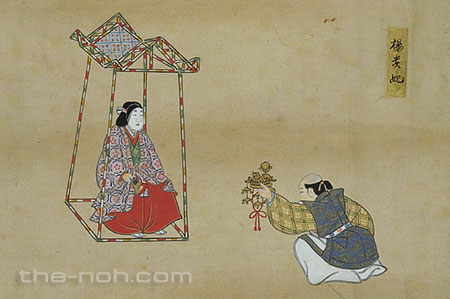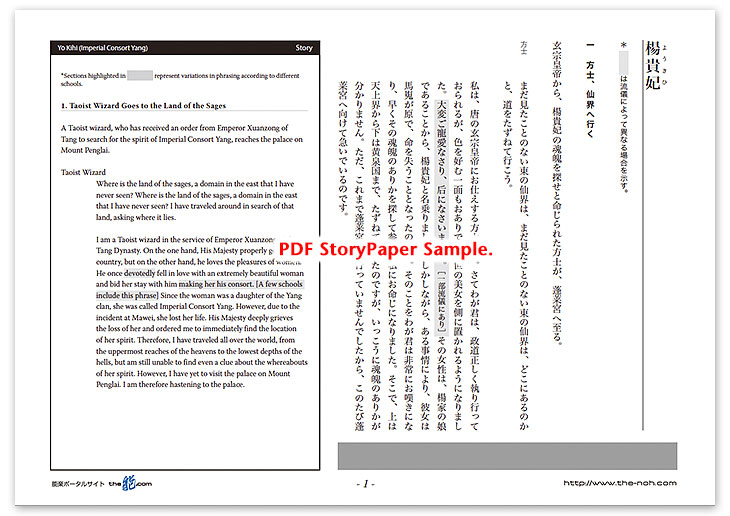
 Yō Kihi (Imperial Consort Yang)
Yō Kihi (Imperial Consort Yang)

![]()
The Chinese Emperor Xuanzong of the Tang Dynasty cannot forget his concubine, Imperial Consort Yang (Yang Guifei; in Japanese, Yō Kihi), who was killed during the An Lushan Rebellion. He therefore orders a Taoist wizard in his service to find the location of Yang’s spirit. Making full use of the mystic powers of Taoism, the wizard reaches the palace on Mount Penglai and hears of Yang’s whereabouts from an inhabitant of the realm. When he arrives at Taizhen Hall, to which he has been directed, Imperial Consort Yang appears.
The wizard tells Yang about the deep grief of Emperor Xuanzong and asks her to give him something as proof that he has contacted her. Yang agrees to his request and tries to give him a hairpin that she is wearing. However, the wizard asks her to tell him some private conversation she had with the emperor, because the hairpin is a very common object that might not be convincing proof of their meeting. She then tells him about a vow, taken by her and the emperor, to be eternal mates (“In the sky, we will be a pair of birds who always fly together in tandem. On earth, we will be a pair of intertwined trees, our branches always touching.”) That was the vow exchanged between Imperial Consort Yang and Emperor Xuanzong on the night of the Star Festival, when they swore their eternal love to the stars Altair and Vega.
Yang then laments that her unfortunate death has forced her to part from the emperor. She dances nostalgically to the memory of her days lived for love. Holding her hairpin, the Taoist wizard returns to the realm of mortals, and Yang is left alone, sitting in the palace on Mount Penglai.
![]()
The protagonist of this play is Imperial Consort Yang (Yang Guifei; in Japanese, Yō Kihi) of China’s Tang Dynasty, whose name, even today, is synonymous with unparalleled beauty. And the stage is set in the palace on Mount Penglai, which according to Chinese legend, is an island located in the realm of sages, that is, the Taoist immortals. The story begins when a Taoist wizard, a master of the mystical arts, having received the order of Emperor Xuanzong to find his beloved consort Yang, visits her in the land of sages where she resides after her death. This setting makes this piece unique among those classified as Mugen-Noh (“Noh of Illusions” in the Third Group Noh), as a monk encounters a ghost (or spirit) in this world. The source for the storyline is “Song of Everlasting Sorrow” (Chang hen ge), a Chinese epic poem composed by Bai Juyi (772-846) during the Tang Dynasty, in which Bai recounts the tragic love story of Emperor Xuanzong and Imperial Consort Yang. The later-half of the poem is woven into this play. In order to fully appreciate this drama, it is helpful to know some historical background about Imperial Consort Yang and her death. Let us introduce some information, based on the first half of “Song of Everlasting Sorrow.”
Imperial Consort Yang (719-756) was born into the Yang clan of Shu Prefecture and given the name Yang Yuhuan. Her parents died when she was very young, and she was adopted by her uncle. Her incredible beauty led to her marriage to Li Mao, the Prince of Shou and the eighteenth son of Emperor Xuanzong (685-762, the ninth emperor of the Tang Dynasty). However, Emperor Xuanzong was captivated by her beauty and arranged for her to become his own concubine. As Yang became the emperor’s favorite, her family members started to assume key positions in the Tang government. One of them was her cousin, Yang Guozhong (?-756). Yang Guozhong became chancellor and wielded great influence, but eventually he came into severe conflict with a military officer, An Lushan (705-757), who was adopted as an heir by Imperial Consort Yang. As the result of this conflict, An Lushan rebelled against the Tang Dynasty. Under attack from An Lushan’s forces, Emperor Xuanzong had to flee the capital, Chang’an, along with Imperial Consort Yang and Yang Guozhong. When the group arrived in Mawei, the imperial army escorting the emperor killed Yang Guozhong, accusing him of fomenting An Lushan’s rebellion. The army then pressed the emperor to order the execution of Imperial Consort Yang. In the end, Emperor Xuanzong was compelled to order that Yang be strangled to death. “Song of Everlasting Sorrow” describes the events after the rebellion had been put down and the emperor, in deep grief, ordered the Taoist wizard to find the spirit of Imperial Consort Yang. These events are the basis of this Noh play.
We may wonder why the spirit of Imperial Consort Yang is residing in the land of the sages. The probable explanation is that she had renounced the world and become a Taoist nun before being engaged as the concubine of Emperor Xuanzong. This step was taken because the emperor did not want to flagrantly wrest away his own son’s wife. As a Taoist nun, Yang took the name Taizhen which, in this Noh play, is also the name of the hall she resides in.
The chanting and dance convey the elegance, sophistication, loneliness, and quietude vividly depicted in the theme of this piece, the deep bond of love between Imperial Consort Yang and Emperor Xuanzong and their feelings of profound sorrow upon being separated from each other. Knowing this historical background, the play is all the more fascinating.
STORY PAPER : Yō Kihi (Imperial Consort Yang)
Story Paper presents noh chant stories in modern speech, with story outlines, highlights and more using Adobe PDF format, which can print out and zoom in. Print out the pages and take them with you when you see the actual noh performance.

The copyright of Story Paper is held by the Noh.com. Story Paper is for individual use only. It is prohibited by the copyright law to distribute or publish printed-out Story Paper pages without prior consent. For more information, check the credit and disclaimer pages.



 [Yō Kihi (Imperial Consort Yang) : Story Paper PDF : 474KB
[Yō Kihi (Imperial Consort Yang) : Story Paper PDF : 474KB